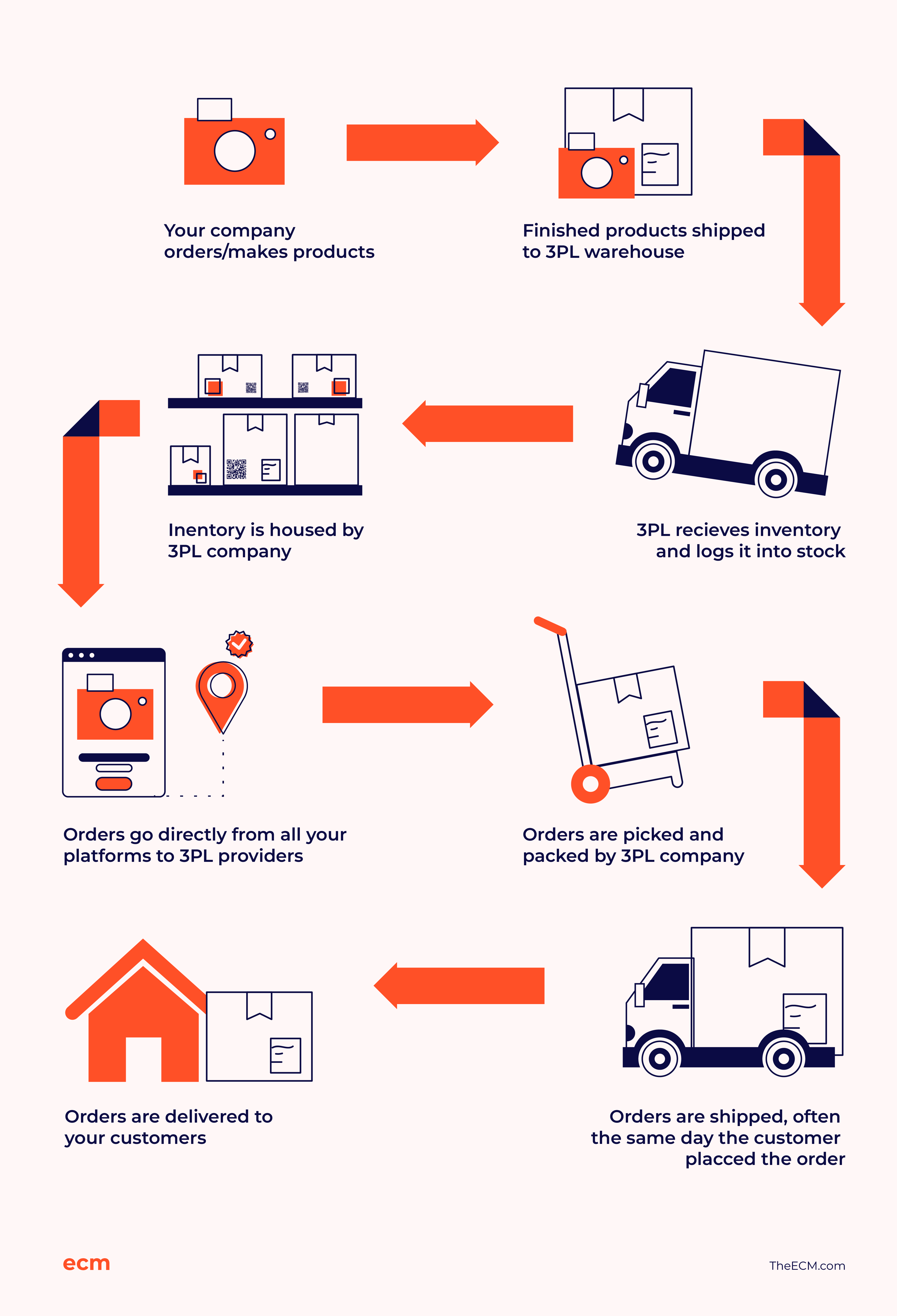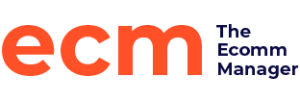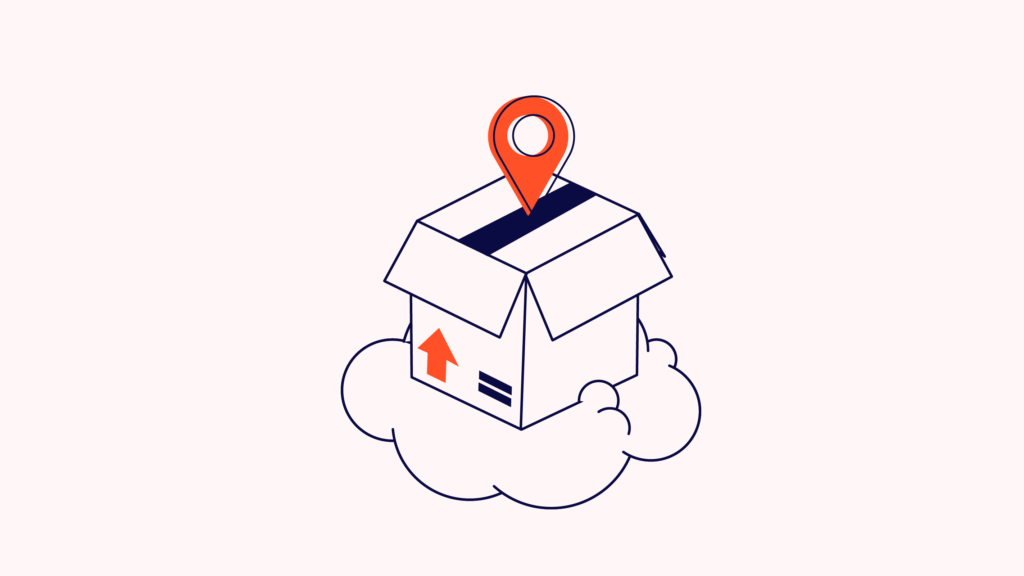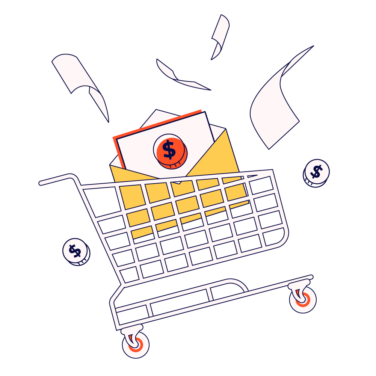In 2020, ecommerce turnover expanded by over 25% and continued to grow even after the pandemic restrictions and lockdowns finished. This led to a huge spike in demand for warehousing, shipping, and logistics services.
Many businesses which had previously done all the logistics in-house now could not keep up with the demand and turned to third-party logistics (3PL) businesses to help them. Now, over 90% of big companies use 3PLs rather than managing logistics in-house.
In this article, I will give you an in-depth guide to 3PL, including what is a 3PL company, what services they offer, and how you can use 3PL services to improve the efficiency of your logistics operations in your ecommerce store. So let’s jump in.
What Is A 3PL (Third-Party Logistics)
Third-party logistics, also known as 3PL, is the outsourcing of the logistics and supply chain operations in your ecommerce business. Logistics include shipping and freight, warehousing, inventory management, order fulfillment, returns, reverse logistics, and other activities.
Originally, third-party logistics providers offered shipping and warehousing services as their main offering. However, since ecommerce has grown and the logistics have become more complex, you’ll now often find 3PL businesses offering more overarching services, including ecommerce fulfillment centers, software solutions, and value-added services such as consulting.
Most third-party logistics companies will allow you to use certain parts of their services rather than using them for all your logistics. For example, you may just need inventory to be stored in a warehouse before it is shipped on-bulk to Amazon FBA centers. This is the exact reason I first needed a 3PL after Amazon introduced inventory limits. Or you may just need a partner to provide the last mile delivery.
The best warehouse management systems (WMS) will integrate seamlessly with your overall order management system, so you can keep track of your inventory levels and keep customers informed of the progress of their shipments.
How Does 3PL Work?
The role of a 3PL provider in supply chain management is to work with various partners, such as carriers, warehouses, and other service providers, allowing you to concentrate on growing the business.
Generally, when you work with a 3PL, you will be outsourcing all elements of the logistics process to the 3PL, but some let you pick and choose which parts you need to use. This is a typical 3PL journey for an ecommerce business:
- You have manufactured a new product in China and arranged for it to be shipped.
- The manufacturer or shipper contacts the 3PL to arrange a delivery slot.
- The inventory is shipped to the 3PL, and the 3PL receives the stock and organizes it in its warehouse system.
- The stock levels are updated in the inventory management system, and stock is shown as available on your website.
- When a customer order is placed, the 3PL gets a notification and then picks the stock from the shelves and prepares it for shipment with a shipping receipt and any additional packaging. The inventory management system is updated.
- The shipping label is printed by the 3PL and attached to the parcel.
- The 3PL arranges for a shipping carrier to collect the stock from the 3PL’s warehouse, and the product is shipped to the customer.
- The order is delivered to the customer, and the order management system is updated.

How Much Does A 3PL Cost?
Generally, 3PL partners will charge you for their services in 5 ways:
- Per item fulfillment: This is the cost for picking, packing, and shipping each item.
- Monthly storage: Warehouse space is usually charged on a square footage basis, or per pallet, depending on the 3PL.
- Receiving fees: 3PLs will usually charge a small fee for receiving a big shipment. This is to cover costs such as forklift trucks and staff.
- Sending fees: If you are storing stock in boxes to be shipped to another warehouse, such as FBA, then the 3PL will charge you shipment on a per-box basis.
- Inspection fees: Fees for inspecting and auditing the products.
- Other fees: Sometimes, you have an unusual request, such as assembling, repackaging, or bundling. These are usually charged on a “man-hour” basis.
What Services Does A 3PL Provide?
There are different kinds of 3PLs, and the services you need will depend on the size of your business.
For example, if you are a small Etsy seller, making your own products and shipping them directly to the customer, your first use of a 3PL may be just a local warehouse to store your finished products or even your warehouse in your garage.
However, if you are an enterprise business, you may be looking for a more integrated solution that is completely managed externally. This is sometimes called 4PL or fourth-party logistics. 4PLs act as logistics management for the whole system, which means you just have one point of contact for your whole supply chain and fulfillment process.
Whichever way you use a 3PL, there are certain functions that most 3PLs will offer.
Warehousing
Warehousing is the most important part of 3PLs. If you are a small ecommerce seller using your garage as a warehouse, then you are going to run out of space for stock first and time to ship orders second.
3PLs have different kinds of warehouses depending on the type of stock you are storing. For example, if you sell food or expirable products, then you need a warehouse that specializes in that. If your business sells fragile or hazardous products, such as perfume in a glass bottle, you will need a warehouse that can manage to handle these kinds of products.
Some 3PLs will specifically exclude you from selling a particular kind of product unless you have the correct documentation. A good example of this is Amazon FBA. While FBA isn’t just a 3PL but more of an overall marketplace fulfillment solution, they have a lot of restrictions and rules on the items you can store in their warehouses.
Some of the restrictions might not be something you have thought of. Meltable items such as candles and chocolate often need to be certified to be stored at a certain temperature, battery products need to be stored in a certain humidity, and baby and children products need specific storage conditions.
When choosing a 3PL, make sure you check that your products are suitable for the facilities that the 3PL has.
Inventory management
Most 3PLs will use some kind of warehouse and inventory management software system to track your stock. Some 3PLs have very sophisticated software solutions that have API integrations with your inventory management system, while this may be massive overkill for some ecommerce brands.
When you are speaking to a 3PL, try to understand what software they use, what integrations their software supports, and whether it is suitable for the way you currently manage your inventory.
Inventory management is really important in an ecommerce business. If you aren’t accurately reporting on the stock data, you could go out of stock, order too much stock and lose money, or have stock that goes past its expiry date.
Order fulfillment and management
When stock arrives in the warehouse, the 3PL will either open the boxes and arrange the stock on their shelves or keep the stock on pallets, depending on whether they are organizing the shipping to the customer.
If the 3PL is arranging the shipping, then they will need to arrange the picking, packing, and shipping. Some 3PLs will use your protective packaging to ship the orders, and some will just use generic packaging.
3PLs can also handle customer returns and inbound shipments, and the best 3PLs will even offer returns inspections so you can see why a product is returned. Using a 3PL for returns is very efficient and will save you a lot of time.
Having a good returns process is very important for your overall customer experience, so outsourcing them handled by a professional 3PL provider is a great idea.
Shipping and freight management
Whilst 3PLs aren’t usually the shipping or freight provider, they will usually coordinate the shipping and freight with your freight forwarder or shipping carrier.
For freight and palletized shipments, the 3PL will be able to book delivery appointments and have the correct equipment, such as forklift trucks, to receive palletized boxes.
The 3PL also needs the ability to print shipping labels that adhere to the shipping provider’s requirements. For example, Amazon orders have a particular sized label requirement, which could be different from orders shipped by Fedex or UPS, so it’s important to check with the 3PL if they support all shipping options.
Other services
Custom packaging
Some 3PLs are able to offer custom packaging options, allowing you to brand your packaging to give the customer a great unboxing experience.
Product inserts
Product inserts, such as catalogs or flyers, allow you to cross-sell other products in your range. This is a great opportunity to get your products in front of a customer.
Another trend is to cross-sell products from other businesses, which can help you to generate a little more income. Companies such as Blue Market Media can add leaflets to get you some commission when a customer places an order with the other business.
If you want to add in flyers from other businesses, you need to make sure your 3PL can provide that service.
Kitting, bundling, finishing, and assembly
Some 3PLs can also provide kitting, bundling, and assembling. This is particularly useful if you have a product being manufactured in multiple countries or you want to bundle products together to make a new SKU.
Bundling is a great way to increase basket size, especially if some products fit together naturally. For example, if you are selling cosmetics, you might want to make a “Mother’s Day bundle,” which includes multiple products which are repackaged into Mother’s Day packaging.
Assembly is useful if your product is bulky and the shipping is looking expensive. I once sold a planter that sat on a stand. The overall package size for this product was making my freight charges so high, so I flat-packed the stand and shipped the planter separately. The product was then repackaged into one box by the 3PL. This saved me a huge amount of money in freight, and it meant I could inspect the product before it went to the customer.
Some 3PLs will even finish products for you. Some companies have previously used a dodgy tactic called “Tariff Engineering” to lower their import taxes. The products would be made in China, then finished by a business in the U.S. so that the product can be classified as “Made in the USA.” While this tactic is illegal, finishing a product in a 3PL can be a good way to save costs or improve the quality of the finish of a product, and some 3PLs can help with this.
Inspections
When your products arrive at the 3PL, you can have them inspected to make sure they are up to your high standards. For most businesses, the inspection will take place before they are shipped to the 3PL.
However, sometimes you need to have a secondary inspection, for example, if you have had quality issues previously or there has been a communication from your freight team to say that the stock may have been damaged.
Pros and Cons of 3PL
Choosing whether to use a 3PL is an important decision. Here are some of the pros and cons of using one.
Pros
Cost savings
Outsourcing your logistics can be more cost-effective in the long run, as you don’t need to hire staff or rent a warehouse. 3PLs also often have relationships with carriers, which means you can get preferential shipping rates.
Scalability
3PLs can often scale with your business, so they can grow as you grow.
Expertise
3PL companies possess specialized knowledge and expertise in logistics, which can lead to more efficient and effective supply chain management.
Focus on core business activities
The main job of an ecommerce business owner is to grow the business. Outsourcing to the 3PL will relieve you of the problems of managing stock and staff and allow you to work on marketing and sales.
Improved customer service
By working with a 3PL, you are much more likely to ship products on time, which will improve your relationship with your customers.
Cons
Additional costs
While you can save money in the long run, using a 3PL can be expensive. It is important to understand how the 3PL is going to charge you so you can work out your profitability.
Loss of control
By outsourcing to a 3PL, you are gaining their experience, but you are also losing an element of control. However, it is usually worth the risk as you will be working with logistics experts.
Loss of time
It can take time to get set up with a new 3PL, which can affect your bottom line. Also, if you ever need to change 3PL, it can be a time-consuming and expensive process.
Customer communication
When you choose to use a 3PL, you are usually choosing to use their systems. It is important that you understand their systems or have integration into your order management system so you can give customers accurate updates.
Some 3PL Companies To Consider
ShipBob
ShipBob has its own software, which integrates with all the major ecommerce platforms, which is great if you have multiple sales channels. They are based in the U.S., so they aren’t suitable for worldwide sales, but they distribute the stock across their U.S. warehouses to give faster shipping times to customers. The fees are simple to understand, and you get a dedicated account manager.
Flexport
Flexport is a global network that is great for worldwide customers. They also offer transportation services and act as a freight forwarder, so you can have your stock sent from a manufacturer to their warehouses via their freight ships. Having this all in one place can save a lot of time.
Red Stag Fulfillment
U.S.-based warehouse solution that specializes in heavy and bulky items. They have a great customer service team, and their pricing is very transparent.
Fulfillment by Amazon (FBA)
The main advantage of using FBA is you have access to Amazon’s vast network of customers. Their pricing is higher than other warehouses, but in return for that cost, you can sell a lot of stock very quickly.
Another great thing about FBA is it is mostly quite hands-off once the stock is with Amazon, as they handle returns and customer service. However, you will need to write your listings, upload images, and manage Amazon’s ads.
Find A 3PL Partner That Fits Your Business Needs
For most ecommerce businesses, using a 3PL isn’t a choice but a necessity. However, not all 3PLs are the same, so it is important to do your due diligence on whether a 3PL is right for your business.
A 3PL isn’t just a warehouse. It can be a partner for all your logistics and fulfillment needs, so find a 3PL that can grow with your business.
For more insights into ecommerce logistics, along with tips and actionable insights for your online business, sign up for The Ecomm Manager newsletter today.
More great ECM content:
- A Guide To The Global Order Fulfillment Process
- Last Mile Delivery: 5 Tips To Solve the Silent Killer of Supply Chains
- The Best Types of Ecommerce Packaging For Your Online Store: A Complete Guide
- Ecommerce Warehouse Process: Turn It Into A Competitive Advantage
- An Easy Guide To Ecommerce Shipping
- 10 Best Ecommerce Shipping Companies For Ecommerce Sellers
- 10 Best Ecommerce Shipping Software For Ecommerce Sellers
- 10 Best Warehouse Management Software
- 10 Best Order Tracking Software For Online Stores


